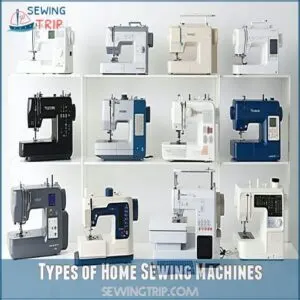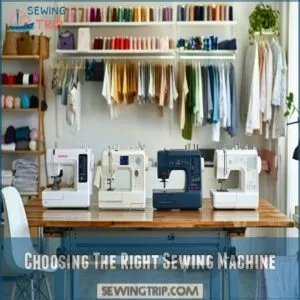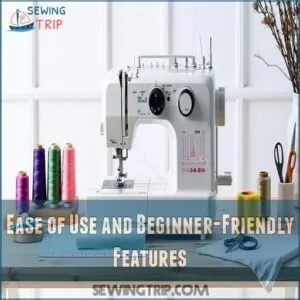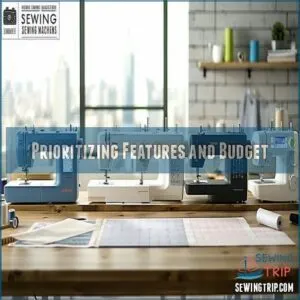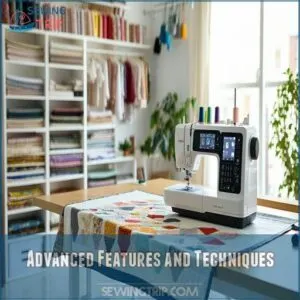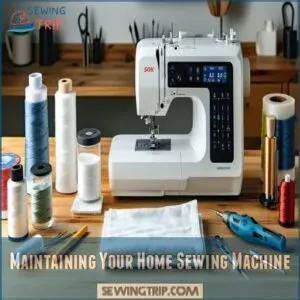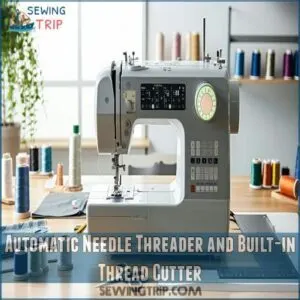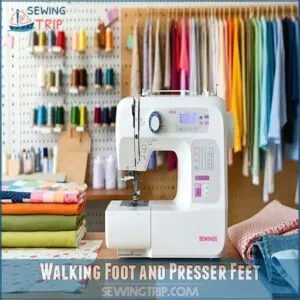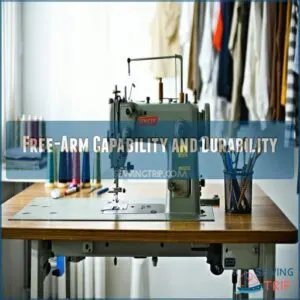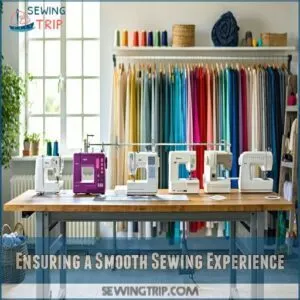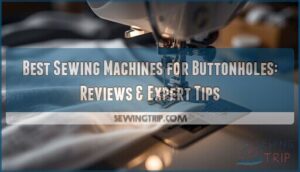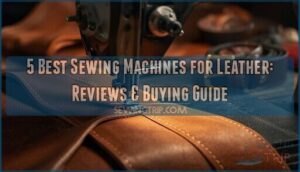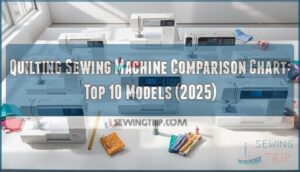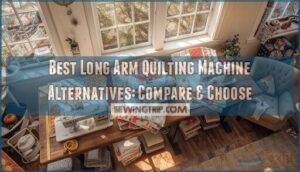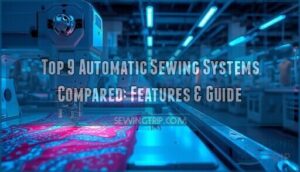This site is supported by our readers. We may earn a commission, at no cost to you, if you purchase through links.
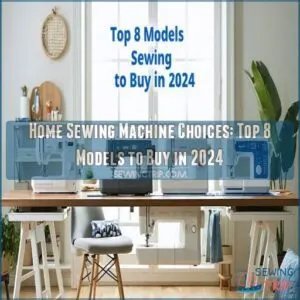 Choosing the right sewing machine means balancing features with your skill level and sewing goals.
Choosing the right sewing machine means balancing features with your skill level and sewing goals.
Mechanical machines, like Singer’s Heavy Duty models, are perfect for basic repairs and straight seams.
Ready for more creativity? Computerized machines, like Janome’s JW8100, handle intricate designs with customizable stitches and automatic threaders.
Need fine finishes? Sergers are your go-to for professional-grade seams, while embroidery machines add flair to fabrics.
For portability, lightweight models like Brother’s XM2701 are excellent.
Think about key features—adjustable stitch length, walking feet, or free-arm capabilities—all made to suit your needs.
Ready to thread your path to sewing mastery? Let’s explore further!
Table Of Contents
- Key Takeaways
- Types of Home Sewing Machines
- Choosing The Right Sewing Machine
- Top 8 Home Sewing Machines
- 1. Brother Computerized Sewing Machine CP60X
- 2. Singer Heavy Duty Sewing Machine
- 3. Janome Sewing and Quilting Machine
- 4. Brother Lightweight Sewing Machine XM2701
- 5. Janome Computerized Sewing Machine JW8100
- 6. Portable Sewing Machine for Mending
- 7. Bernette Swiss Design Sewing Machine
- 8. Brother Computerized Sewing Quilting Machine
- Factors to Consider When Buying
- Maintaining Your Home Sewing Machine
- Key Features to Look For
- Ensuring a Smooth Sewing Experience
- Frequently Asked Questions (FAQs)
- Conclusion
Key Takeaways
- Focus on your skill level and sewing goals to choose the right machine, whether it’s a basic mechanical model or an advanced computerized option.
- Check for essential features like automatic needle threading, adjustable stitch lengths, and free-arm capability for versatility and convenience.
- Heavy-duty machines are ideal for thick fabrics like denim, while lightweight, portable options work best for small spaces or on-the-go projects.
- Prioritize warranty support and brand reputation to ensure long-term reliability and peace of mind.
Types of Home Sewing Machines
In the context of home sewing machines, you’ll find several types designed to match different needs and skill levels.
From mechanical basics to advanced computerized models, there are various options.
And even specialized machines like sergers and embroidery options, there’s something for every project and preference.
Mechanical Vs Computerized Machines
Deciding between mechanical and computerized sewing machines? Let’s break it down:
- Machine Portability: Mechanical models are lighter; computerized ones pack more.
- Control Panel: Computerized machines offer sleek digital precision.
- Stitch Complexity: Digitals boast hundreds of patterns; mechanical sewing machines handle basics.
- Motor Performance: Both shine, but computerized wins on finesse.
Pick what complements your style and skill!
Sergers and Quilting Machines
Sergers and quilting machines are your go-to for specialized sewing needs.
Sergers handle precise seam finishes with Overlock Stitch Options and Automatic Trimming, while quilting machines tackle thick layers with ease.
Selecting proper Serger Thread Types and focusing on Quilting Fabric Selection guarantees smooth results.
For sewing classes or workshops where students need to work with portable machines, incorporating portable sewing machines for sewing classes can be a valuable addition.
Here’s a quick reference:
| Feature | Sergers | Quilting Machines |
|---|---|---|
| Stitch Type | Overlock Stitch Options | Specialized Quilting Stitches |
| Fabric Compatibility | Lightweight to Medium | Heavy Fabrics |
| Key Function | Seam Finishing | Layer Stitching |
| Maintenance | Frequent Thread Changes | Quilting Machine Maintenance |
| Ideal Use | Home Use, Apparel | Sewing Machine for Quilting |
Embroidery Machines and Miniature Machines
Embroidery machines add flair to beginner sewing machine projects, while miniature machines handle compact tasks effortlessly.
Look for these:
- Decorative stitch options for designs that pop.
- Embroidery software for custom creations.
- Machine portability factors, ideal for tight spaces.
- Compact machine storage, perfect for small homes.
- Machine weight comparison, balancing portability and stability, like the Bernina 770 QE Plus.
Choosing The Right Sewing Machine
Finding the right sewing machine means balancing your skill level, project needs, and machine features.
It’s about ensuring the machine fits your goals, whether you’re stitching simple designs or tackling complex projects.
Skill Level and Project Type
Before diving into your sewing journey, let’s match your skill level with the right machine. Here’s a quick guide to help you choose:
To master your chosen machine, mastering the fundamentals is key. For a more detailed understanding, follow Sewing Machine Basics.
| Skill Level | Project Complexity | Recommended Features |
|---|---|---|
| Beginner | Basic repairs, straight seams | Automatic threading, 5-10 basic stitches |
| Intermediate | Simple garments, home decor | Multiple stitch options, adjustable speed |
| Advanced | Quilting, detailed work | Advanced features, specialized feet |
| Expert | Complex garments, embroidery | Computerized controls, specialty stitches |
| Professional | Multiple project types | High-speed capability, industrial features |
You’ll want features that match your experience and handle your planned projects effectively, allowing you to choose the right machine for a more enjoyable sewing experience.
Brand Reputation and Warranty Support
When choosing a home sewing machine, brand reputation speaks volumes about quality and longevity. Look for manufacturers with proven reliability and thorough warranty policies that cover parts and labor.
Top sewing machine brands like Singer, Brother, and Janome have built customer loyalty through excellent repair services and responsive support teams.
Your investment deserves protection, so prioritize brands offering extended warranties and accessible service centers.
Additionally, registered owners can access Sewing Machine Warranty information and support, providing added peace of mind and responsive support teams.
Key Features to Consider
You’ll want a tension control system that plays nice with different fabrics – it’s like having a good DJ who knows just how to mix the beats.
Look for adjustable stitch length and a user interface that matches your comfort level.
The machine’s ergonomic design should feel natural, while fabric compatibility guarantees you’re ready for anything from silk to denim.
Check those sewing machine dimensions and weights too.
Top 8 Home Sewing Machines
You’ll find your perfect match among these eight top-rated sewing machines, which we’ve tested and ranked based on performance, durability, and value for money.
Whether you’re a beginner looking for user-friendly features or an experienced sewer seeking advanced capabilities, our carefully selected lineup includes options from trusted brands.
The brands include Brother, Singer, and Janome that’ll fit your needs and budget.
1. Brother Computerized Sewing Machine CP60X
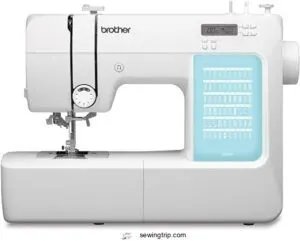
The Brother CP60X stands as a versatile powerhouse with 60 built-in stitches, perfect for both beginners and experienced sewers.
You’ll love the user-friendly features, including a 2-step automatic needle threader and seven different sewing feet for tackling various projects. Its durable metal frame construction handles thick fabrics with ease, while the bright LED workspace keeps your stitching clear and visible.
The machine’s fixed needle bar guarantees clean, even lines, and the drop feed dogs make free-motion sewing a breeze. With advanced features like automatic thread trimming, this machine offers seamless perfection for your sewing needs.
At 14 pounds, it’s substantial enough for stability yet manageable for transport, providing a great balance of user-friendly features, durable metal frame construction, bright LED workspace, and advanced features to ensure a great sewing experience.
Best For: Beginner to intermediate sewers who want a reliable, feature-rich machine that can handle basic projects and grow with their skills.
- Built-in automatic needle threader and Quick-Set bobbin make setup quick and frustration-free
- Solid metal frame construction handles thick fabrics and heavy quilts without skipping
- Versatile 60-stitch selection with 7 buttonhole styles covers most common sewing needs
- Printed instructions can be confusing for new users, requiring additional video tutorial support
- No included carrying case for protection during transport
- White text on light blue display background can be difficult to read in some lighting conditions
2. Singer Heavy Duty Sewing Machine
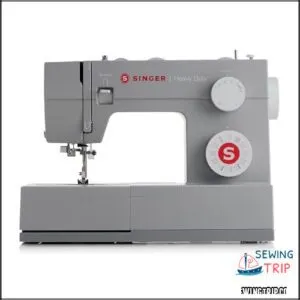 View On Amazon
View On Amazon Right out of the box, Singer’s Heavy Duty Sewing Machine means business with its enhanced piercing power and solid metal frame.
Its 110 stitch applications cover everything from basic to decorative patterns, while the one-step buttonhole feature saves precious time.
You’ll love the convenience of the top drop-in bobbin with its clear cover for easy monitoring. The built-in needle threader eliminates eye strain.
Six specialized presser feet tackle various projects with ease. Plus, it comes loaded with essential accessories, making it ready for any sewing challenge.
Best For: This machine is ideal for sewists who regularly work with heavy fabrics like denim and canvas, or those who need a durable workhorse for frequent use.
- Powerful motor and metal frame provide exceptional stability and piercing power for thick materials
- Comprehensive set of 110 stitch options gives you versatility for different projects and decorative work
- Complete accessory package with six presser feet and essential tools means you can start sewing right away
- At 14.6 pounds, the machine’s weight can
3. Janome Sewing and Quilting Machine
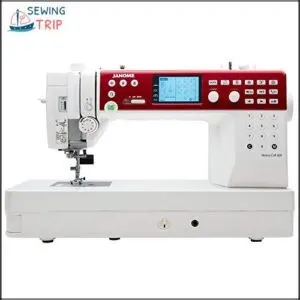 View On Amazon
View On Amazon Packed with an impressive 170 built-in stitches and two alphabets, Janome’s MC6650 puts professional-level quilting at your fingertips.
You’ll love the spacious 10-inch all-metal flatbed that makes handling large projects a breeze, while six strategically placed LEDs illuminate your work area perfectly.
The machine’s one-push needle plate conversion and superior needle threader streamline your workflow.
With speeds up to 1,000 stitches per minute and automatic thread cutting, you can tackle everything from delicate details to heavy quilting projects with confidence.
Best For: Experienced sewists and quilters seeking a professional-grade machine with extensive stitch options and a spacious work area for larger projects.
- The generous 10-inch metal flatbed and excellent LED lighting system make handling large quilting projects comfortable and precise
- Impressive array of 170 built-in stitches and two alphabets provides extensive creative possibilities
- Fast 1,000 SPM speed combined with automatic thread cutting and superior needle threading system boosts productivity
- Some users report issues with thread skipping and the automatic thread cutter functionality
- Additional accessories like the knee presser foot lift must be purchased separately
- Learning curve may be steep for beginners due to the extensive features and settings
4. Brother Lightweight Sewing Machine XM2701
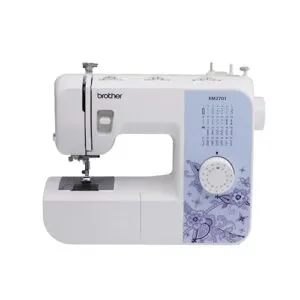 View On Amazon
View On Amazon The Brother XM2701 stands out as a versatile companion for both beginners and seasoned sewers.
The machine’s physical attributes make it an ideal choice for various settings. It has a lightweight design at just 12.6 pounds, making it perfect for small spaces or portable sewing stations.
In terms of functionality, the machine comes equipped with 27 built-in stitches, including decorative and blind hem options. Additionally, the automatic needle threader saves your eyes from strain.
The machine also features a jam-resistant drop-in bobbin and a one-step buttonholer, allowing you to breeze through projects like hemming pants and creating towels.
Plus, the 25-year warranty guarantees long-term peace of mind.
Best For: Beginners and intermediate sewers looking for an easy-to-use, lightweight machine for everyday sewing projects.
- Lightweight and portable design perfect for small spaces.
- 27 built-in stitches including decorative, stretch, and blind hem options.
- Automatic needle threader and drop-in bobbin simplify setup.
- Foot pedal can feel sticky and may require extra pressure.
- Not ideal for heavy materials like thick denim.
- Warranty only valid for U.S. usage at 120 volts.
5. Janome Computerized Sewing Machine JW8100
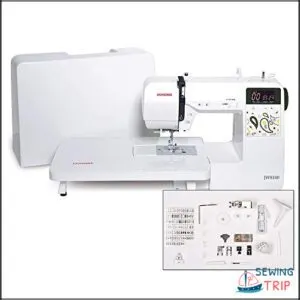 View On Amazon
View On Amazon You’ll find the JW8100 strikes a perfect balance between sophisticated features and user-friendly operation.
With 100 built-in stitches and 7 auto buttonhole styles, you’re equipped for virtually any project.
Its memorized needle up/down function and speed control slider make precision work a breeze.
The metal frame provides rock-solid stability, while the 7-piece feed dog system guarantees smooth fabric handling.
Plus, you’ll appreciate thoughtful extras like the extension table and hard-sided dust cover.
For quilters and sewists who value versatility, this machine delivers outstanding value.
Best For: Hobbyist sewists and quilters who want a reliable, feature-rich machine with room to grow their skills.
- Extensive stitch library and auto buttonhole styles provide versatility for various projects
- Solid metal frame construction and quality feed dog system ensure consistent, reliable performance
- Valuable included accessories like the extension table and even feed foot enhance quilting capabilities
- White color may show dirt and wear more easily than darker machines
- Multiple features might feel overwhelming for complete beginners
- Takes up considerable space with the extension table attache
6. Portable Sewing Machine for Mending
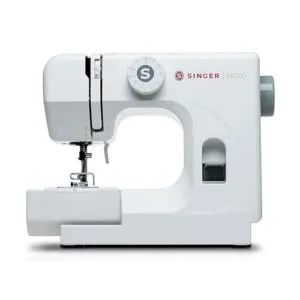 View On Amazon
View On Amazon For beginners and occasional sewers, Singer’s M1000 proves itself as a reliable companion for quick fixes and simple projects.
Weighing just 5.5 pounds, it’s compact enough to store in tight spaces while offering 32 essential stitch applications.
You’ll appreciate the transparent bobbin cover and easy threading guides that make setup a breeze.
While it mightn’t tackle heavy-duty projects, this budget-friendly machine shines at basic alterations and mending tasks.
Its finger guard safety feature and clear instruction manual guarantee you’re stitching confidently from day one.
Best For: Beginners, hobbyists, and those needing a lightweight portable machine for basic mending and simple sewing projects.
- Extremely portable at just 5.5 pounds with compact dimensions, making it perfect for small spaces and travel
- User-friendly features including transparent bobbin cover, easy threading guides, and clear instruction manual
- Affordable price point with 32 stitch applications covering essential sewing needs
- Not suitable for heavy-duty projects or thick fabrics
- Some users report issues with thread breaking and bobbin problems
- May need replacement after extended use, with several users noting reliability concerns
7. Bernette Swiss Design Sewing Machine
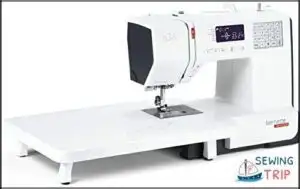 View On Amazon
View On Amazon Bernette’s Swiss-engineered sewing machine stands out with its impressive 394 built-in stitches and eight one-step buttonholes.
You’ll love the smart features like automatic thread cutting and an LED display that lets you control sewing speed. The machine includes eight presser feet and an extension table for larger projects.
It’s whisper-quiet during operation and delivers consistent, uniform stitches.
What makes it especially user-friendly is the automatic double-needle limitation that prevents breakage and the adjustable presser foot pressure for different fabrics.
Perfect for beginners or experienced sewists alike.
Best For: Beginner to intermediate sewists who want a feature-rich computerized machine with room to grow their skills.
- Impressive variety of 394 built-in stitches and eight buttonhole styles gives you plenty of creative options
- Smart features like automatic thread cutting and speed control make sewing easier and more efficient
- Comes well-equipped with eight presser feet and an extension table for handling different project types
- At 21.8 pounds, it’s on the heavier side which affects portability
- Price point may be steep for casual hobbyists just starting out
- Limited information available about material construction and durability
8. Brother Computerized Sewing Quilting Machine
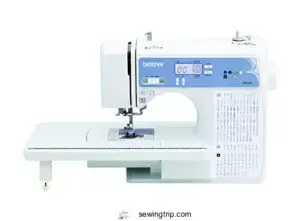
While you might think computerized machines are complex, the Brother XR9550 makes quilting and sewing a breeze. You’ll love its 165 built-in stitches, including 110 decorative options and 55 alphanumeric designs.
The LCD display helps you navigate settings effortlessly, while the automatic needle threader saves your eyes from strain.
The included wide table and eight specialized feet give you plenty of room for larger projects. Though lightweight, it handles most fabrics well and runs quietly.
Just keep in mind it’s designed for US voltage (120V).
Best For: Intermediate sewers and quilters seeking a feature-rich computerized machine with versatile stitch options and convenient automated features.
- Extensive collection of 165 built-in stitches, including decorative and alphanumeric options, provides creative flexibility for various projects
- User-friendly features like automatic needle threading, drop-in bobbin, and intuitive LCD display make operation straightforward
- Comes with essential accessories including a wide table and 8 specialized feet, plus lifetime technical support from Brother
- Limited to 120V US power systems, making it unsuitable for international use
- Build quality feels somewhat flimsy compared to higher-end machines
- May overwhelm complete beginners with its extensive features and computerized interface
Factors to Consider When Buying
You’ll need to match your sewing machine’s features with your skill level and intended projects to make the right choice for your crafting journey.
When you’re shopping for a sewing machine, focus on essential factors like stitch options, ease of use, and durability to guarantee you get the best value for your money.
Ease of Use and Beginner-Friendly Features
Looking for your first sewing machine?
Start with user-friendly features that’ll make your learning curve smoother. The best home sewing machines for beginners come with automatic tensioning and one-step buttonholes to prevent common mistakes.
Look for clear thread management systems and error correction features that’ll catch problems before they start. A simple user interface lets you focus on creating rather than troubleshooting.
Choosing the right machine also depends on understanding what is the easiest sewing machine to use, a key factor in ensuring an enjoyable sewing experience for beginners.
Prioritizing Features and Budget
When comparing home sewing machine features, start by identifying your must-haves versus nice-to-haves.
A smart budget impact analysis shows that basic mechanical machines offer cost-effective options around $150-200, while computerized models with advanced features range from $400-800.
Investing in an Automatic Sewing Machine can greatly improve efficiency and accuracy.
Focus on value for money by prioritizing essential features like automatic threading, adjustable speed control, and multiple stitch options that match your project needs, including automatic threading.
Advanced Features and Techniques
Now that you’ve set your budget, let’s explore what advanced sewing machine features can do for your projects.
Modern computerized sewing machines pack some impressive capabilities that’ll take your crafting to new heights.
- Custom Stitch Options and Thread Management systems help you create intricate designs without the headache
- Automatic Tension Control and Precision Presser Feet make working with tricky fabrics a breeze
Advanced quilting techniques become possible with features like pivot functions and automatic height adjustment.
Maintaining Your Home Sewing Machine
You’ll need to give your sewing machine regular TLC to keep it humming along smoothly for decades to come.
With proper maintenance and care, even a budget-friendly machine can serve you well for 20-plus years, saving you time and money on repairs.
Proper maintenance
Regular Cleaning and Oiling
Keeping your sewing machine in top shape doesn’t have to be complicated.
A weekly cleaning routine with a lint brush removes fabric debris from the bobbin area and feed dogs.
Apply one or two drops of sewing machine oil to moving parts every 8-10 hours of use.
Don’t forget to check your machine’s filters monthly – they’re like the lungs of your trusty stitching companion.
Troubleshooting Common Issues
A sewing machine troubleshooting guide can save you time and frustration.
Address common issues with these tips:
- Thread Breakage Causes: Re-thread carefully or switch to quality thread.
- Incorrect Tension: Test on scrap fabric; tweak settings.
- Bobbin Troubles: Verify it’s wound correctly.
- Needle Damage Prevention: Replace dull needles promptly.
- Machine Overheating Solutions: Pause during long projects to cool it down.
Warranty and Repair Options
A sewing machine warranty isn’t just paperwork—it’s peace of mind. Look for extended warranties, clear repair costs, and strong manufacturer support.
Regular maintenance schedules keep machines running like clockwork. For repairs, check local service options or follow your machine’s troubleshooting guide.
Stay proactive with sewing machine maintenance tips to avoid issues before they arise. Quickly fix it, stitch it!
| Feature | What It Covers | Duration | Cost Range | Where to Look |
|---|---|---|---|---|
| Standard Warranty | Defects, basic parts | 1-2 years | Included | Manufacturer’s manual or website |
| Extended Warranty | Full machine, repairs | Up to 5 years | $50-$150 | Optional purchase at checkout |
| Local Service Centers | Repairs, maintenance | On-demand | $30-$100/hr | Local sewing shops, online search |
| Manufacturer Support | Diagnosis, guidance | Varies by brand | Free | Phone or online support |
| Troubleshooting Guide | Simple fixes | Unlimited | Free | Your machine’s manual |
Key Features to Look For
When choosing a sewing machine, it’s important to focus on features that enhance usability and efficiency.
Look for built-in tools like an automatic needle threader, walking foot attachments, and free-arm capability to make sewing smoother and more precise.
Automatic Needle Threader and Built-in Thread Cutter
Simplify your stitching with features that cut hassle.
The automatic needle threader saves time and reduces eye strain, especially for tricky threads. You can find needle threader tools(automatic needle threader) online to upgrade your sewing experience.
The builtin thread cutter trims threads cleanly with just a button press, boosting efficiency.
- Thread Management: Say goodbye to frayed ends.
- Needle Safety: No more mishaps from manual threading.
- Cutter Maintenance: Minimal upkeep keeps trims precise.
Walking Foot and Presser Feet
For precision and versatility, home sewing machines rely heavily on presser feet.
From zipper foot uses that ease tricky installations to Teflon feet benefits for sticky fabrics, the options are endless.
Walking foot techniques are perfect for tricky layers or quilting, while edge joining methods make piecing seamless.
Utilizing a walking foot for quilting can greatly improve the quality of your projects by keeping fabric and batting layers together.
Sewing machine presser feet truly elevate your projects, offering precision and versatility in various applications, including quilting.
Free-Arm Capability and Durability
When you’re tackling sleeves, cuffs, or small projects, a free-arm design is a game-changer.
Look for a heavy-duty home sewing machine made with durable materials and a solid sewing machine framework. Reliable features guarantee longevity and smooth stitching.
- Navigate tight spaces effortlessly with free-arm capability.
- Opt for built-in stabilizers for precision.
- Choose durable materials for heavy-duty performance.
- Trust home sewing machine reviews for the best sewing machines.
Ensuring a Smooth Sewing Experience
To guarantee your sewing projects go smoothly, match your machine’s features to your skill level and the types of fabrics you use most.
Don’t forget to explore advanced options that can make challenging techniques easier and more efficient.
Matching Skill Level With Machine Features
Your first sewing machine shouldn’t feel like piloting a spaceship. Focus on a sewing machine for home use with a gentle Machine Learning Curve.
Assess your skills using Skill Assessment Tools, and stick with beginner sewing machines emphasizing ease—like a simple User Interface Design.
Avoid Feature Overload Prevention by skipping excessive stitch options. Reviews and ratings help.
Considering Project Types and Fabric
Fabric weight and type can make or break your project.
For lighter fabrics like cotton, even basic machines work well.
Tackling leather sewing or vinyl sewing? A heavy-duty home sewing machine is your best bet.
Match stitch suitability to fabric sewing needs—delicate seams for silk, sturdy finishes for denim.
Complex projects demand machines ready for heavy fabrics and intricate seam finishes.
Exploring Advanced Features and Techniques
Advanced sewing machines bring innovation to every project.
With advanced stitch options, machine customization, and digital display features, you’ll work smarter, not harder.
Explore innovative foot designs for precision or a sewing machine free arm for tricky areas.
A drop-in bobbin makes setup easy, while high-speed stitching handles big projects quickly. Multifunctionality guarantees seamless creativity and control.
Frequently Asked Questions (FAQs)
Which sewing machine has the least problems?
Think of the Janome HD5000 as the trusty Swiss Army knife of sewing machines—durable, simple, and reliable.
It’s built to handle everyday projects without frequent breakdowns, making it a top pick for hassle-free sewing.
Is singer or brother better?
Singer and Brother both shine, but it depends on your goals.
Singer wins for heavy-duty work and simplicity. Brother excels at advanced features and affordability.
Pick Singer for durability, Brother for versatility and tech perks.
Is new home sewing machine the same as Janome?
New Home sewing machines are actually Janome.
Janome acquired the New Home brand in the 1960s, so their machines are basically one and the same—offering reliability, quality, and innovative features under a trusted name.
Is it good to have a sewing machine at home?
Having a sewing machine at home is like having your own creative toolkit.
It saves money on repairs, lets you modify clothes, and fuels DIY projects.
Plus, it’s surprisingly relaxing once you get the hang of it.
What sewing machine options are best for kids?
Think of kids’ sewing machines like training wheels for sewing—lightweight, easy to use, and safe.
Models like the Janome Fastlane or Singer Start 1304 offer simple controls, built-in stitches, and durable designs perfect for young learners.
How to choose a sewing table or cabinet?
Pick a sewing table with sturdy construction, ample surface space, and adjustable height.
Look for built-in storage for tools, smooth drawers, and a drop-down feature for your machine.
Compact designs work well in smaller spaces.
Can vintage sewing machines be good for beginners?
Using a vintage sewing machine can feel like driving a classic car.
Their simplicity makes them beginner-friendly, with fewer distracting features and a focus on mastering foundational skills.
They are reliable, sturdy, and built to last.
What are the benefits of a dual voltage machine?
A dual voltage sewing machine lets you sew anywhere in the world without worrying about power differences.
It’s perfect for travelers or expats, saving you from bulky converters and ensuring consistent performance across various voltages.
Are there sewing machines compatible with mobile apps?
Yes, some sewing machines, like the Singer 6800C and Bernette B79, connect to mobile apps.
With these apps, you can access tutorials, customize settings, and even upload embroidery designs for advanced projects.
Can sewing machines handle thick denim or leather?
Nearly 80% of sewing machines can handle lightweight denim, but thick denim or leather requires heavy-duty models.
Look for ones with powerful motors, adjustable presser feet, and specialized needles to avoid needle breakage and skipped stitches.
Conclusion
Did you know 60% of sewing enthusiasts prioritize user-friendly machines when upgrading?
Choosing from 2024’s top home sewing machine choices comes down to your skill level, project needs, and budget.
Whether you’re eyeing a reliable Singer for heavy-duty tasks or a computerized Brother for creative quilting, there’s a perfect fit.
With features like walking feet and free-arm capabilities, crafting becomes seamless. Ready to stitch? Explore these options and turn your sewing goals into reality!
- https://www.southernliving.com/best-sewing-machines-8350364
- https://www.diaryofaquilter.com/10-tips-for-sewing-machine-success/
- https://www.nytimes.com/wirecutter/reviews/best-sewing-machine/
- https://www.marthastewart.com/1509147/how-to-clean-oil-and-maintain-sewing-machine
- https://sewingtrip.com/best-worst-sewing-machine-brands/

